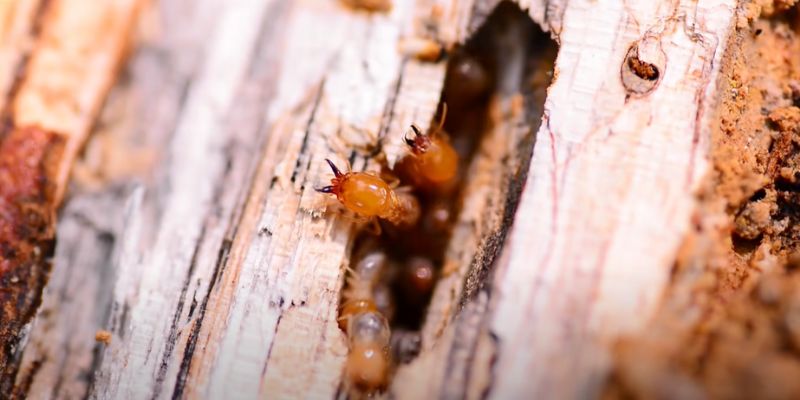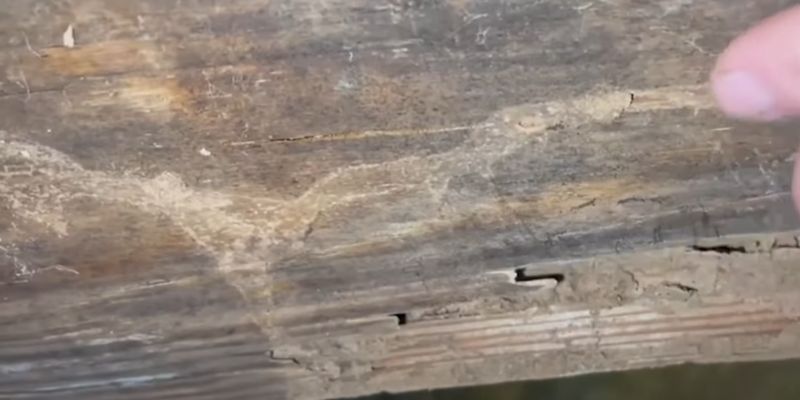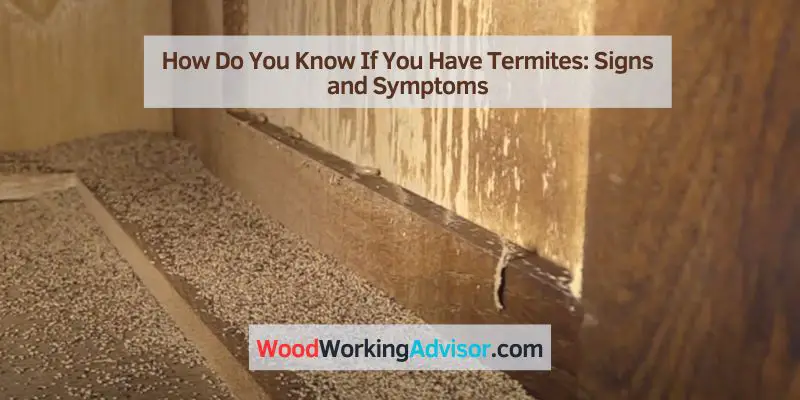One way to determine if you have termites is by noticing small holes in wood surfaces. Additionally, look for mud tubes along walls or foundation.
You might also see discarded wings near windowsills or light fixtures, indicating a termite swarm. Termites are silent destroyers that can cause significant damage to your property without you even knowing. Knowing the signs of a termite infestation is essential for early detection and prevention.
Keep an eye out for any of the aforementioned indicators, and if you suspect you have termites, it’s crucial to seek professional help promptly. Taking proactive measures can save you from costly repairs and potential structural damage to your home. Professional termite inspections are also recommended to ensure the safety and integrity of your property.
Termites Infestation Indicators
Termites infestation can cause serious damage to your property, making it crucial to be able to identify signs of their presence. Understanding the indicators of a termite infestation is essential for early detection and effective treatment. In this post, we’ll guide you through the common indicators of a termite infestation, from understanding termite biology to recognizing environmental conditions that favor their presence.

Understanding Termite Biology For Accurate Identification
Before being able to identify a termite infestation, it’s important to understand the biology of these destructive pests. Termites are social insects that live in colonies, and they primarily feed on wood and cellulose-based materials. They are often mistaken for ants, but termites have straight bodies, straight antennae, and uniform wings. Being able to distinguish between termites and ants is crucial for accurate identification.
Common Environmental Conditions Favoring Termite Presence
In order to effectively prevent and identify termite infestations, it’s essential to recognize the environmental conditions that favor their presence. Termites thrive in warm and humid environments, making areas with excessive moisture particularly susceptible to infestations. Additionally, wood-to-soil contact and untreated wood can make properties more attractive to termites. Keeping an eye out for these conditions can help in early detection and prevention of termite infestations.
Visible Signs Of Termites
Termites are secretive pests, and detecting them can be challenging. However, there are some visible signs that may indicate a termite infestation in your home. Being aware of these signs can help you take timely action to prevent extensive damage. Below are some of the most common visible signs of termites:
Mud Tubes On Exterior Walls As Highways For Termites
One of the most noticeable signs of a termite infestation is the presence of mud tubes on exterior walls. These tubes serve as highways for termites, providing them with protection from predators and preserving moisture that they require to survive. If you notice these mud tubes, it’s crucial to address the issue promptly.
Hollow-sounding Timber And Crumbling Wood Structures
Another visible sign of termites is the damage they cause to wood structures. If you tap on a wooden surface and it produces a hollow sound, or if the wood appears to be crumbling easily, it could indicate termite infestation. These pests feed on wood from the inside out, leaving a thin veneer that can easily be punctured, making the structure weak and prone to collapse.
Unexplained Piles Of What Appears To Be Coarse Grains Of Sand
Moreover, finding unexplained piles of coarse grains of sand-like material in your home can be indicative of a termite infestation. These tiny pellets, known as frass, are the waste materials produced by termites as they tunnel through wood. When you notice these piles, it’s essential to investigate further to determine if termites are the cause.
Being vigilant for these visible signs can help in early detection of termite infestations, allowing you to take necessary measures to protect your property.
How To Detect Termites Early
When it comes to protecting your home from termites, early detection is key. Detecting termites at an early stage can save you from significant damage and costly repairs. By knowing how to spot the early signs of termite infestation, you can take proactive measures to protect your property. Here are the key indicators to look out for in order to detect termites early.
Spotting Discarded Wings From Termite Swarmers
One of the first signs of a termite infestation is the presence of discarded wings from termite swarmers. Termites swarm as part of their mating ritual, and once they have found a suitable mate and a location to establish a new colony, they shed their wings. Spotting these discarded wings around your property, especially near doors and windows, can indicate the presence of termites.
Identifying Termite Droppings, Known As Frass
Another way to detect termites early is by identifying termite droppings, commonly referred to as frass. Termite frass resembles sawdust or wood shavings and is often found near the entry points of termites. It is important to regularly inspect areas such as basements, crawl spaces, and attics for the presence of frass as it could be a clear indication of termite activity.
Presence Of Damaged Or Hollow-sounding Wood
Inspecting the wood in and around your home is crucial for early termite detection. Termite infestations often lead to damaged or hollow-sounding wood. By tapping on the wood surfaces, you can identify areas that sound hollow, indicating possible termite damage. Additionally, look for wood that appears blistered or darkened, as these are also signs of termite activity.
Termite Detection Techniques
Termite infestations can cause significant damage to your home, so it’s important to be proactive in detecting these pests to prevent potential costly repairs. Learning how to spot signs of a termite infestation early on can help you take necessary steps to protect your property. There are various termite detection techniques, including professional inspections and do-it-yourself checks, that can help you identify potential termite presence.
Professional Termite Inspection Methods
Professional termite inspections are conducted by trained pest control professionals who have the expertise and tools to thoroughly assess your property for termite activity. They use advanced techniques and equipment, such as moisture meters, infrared cameras, and acoustic sensors, to detect termites that may be hidden within your walls, floors, or ceilings. These professionals can identify the type of termites present and assess the extent of the infestation, providing you with valuable insights and recommendations for treatment.
Do-it-yourself Checks: What To Look For And Where
If you want to conduct your own termite inspection, there are certain key areas to focus on. Start by inspecting the exterior of your home, looking for signs of termite activity such as mud tubes, discarded termite wings, or wood damage. Check the foundation of your home for any cracks or entry points where termites could gain access. Inside your home, inspect areas of high moisture, such as the kitchen and bathroom, as termites are attracted to damp environments. You can also tap on wood surfaces to listen for hollow sounds, which could indicate termite damage.
Additionally, pay close attention to wooden furniture, windowsills, and door frames for any visible signs of termites. Regularly maintaining your property and keeping it free of excess moisture can help reduce the risk of termite infestations.

Termite Signs In Home Interiors
Termites can cause significant damage to your home, especially if their presence goes unnoticed. It’s essential to be aware of the signs of a termite infestation so you can take prompt action to address the problem. Here are some key indicators to look for within the interiors of your home.
Bubbling Or Peeling Paint That Resembles Water Damage
An unusual sign of termite presence is when the paint on your walls or ceilings starts to bubble or peel, resembling water damage. Termites create moisture when they eat through wood, which can cause the paint to bubble or peel. If you notice this type of damage, particularly in areas that aren’t exposed to moisture, it could be a sign of termite activity.
Tapping Test: Detecting Hollow Spots In Wood
Performing a tapping test can help in detecting the presence of termites. When you tap on wood surfaces and hear a hollow sound, it could indicate that the wood has been hollowed out by termites. This method can be particularly useful for identifying termite-infested areas, such as window sills, door frames, and wooden furniture.
Bowing Walls Or Ceilings Indicating Termite Tunnels
Another significant termite sign is the presence of bowing walls or ceilings, indicating the formation of termite tunnels within the structure of your home. Termites create tunnels as they move through the wood, causing the affected surfaces to warp or bow. If you notice any unusual changes in the shape of your walls or ceilings, it’s essential to have them inspected for termite activity.
Frequently Asked Questions Of How Do You Know If You Have Termites
What Are The Signs Of Termites In Your Home?
Signs of termites in your home include hollow-sounding wood, discarded wings, mud tubes on exterior walls, and tight-fitting doors or windows. Additionally, you may notice small piles of sawdust-like material. Regular inspections can help detect termites early and prevent extensive damage.
What Does A House Look Like With Termites?
A house with termites may have hollow-sounding or damaged wood, mud tubes, and droppings. Walls and ceilings may also show bubbling paint or visible tunnels. It’s important to address a potential termite issue immediately to prevent further damage.
Do Termites Just Show Up?
Termites can show up unexpectedly, often going undetected until serious damage occurs. Regular inspections can help prevent infestations.
Is It Safe To Live In A House With Termites?
Living in a house with termites is not safe. Termites can cause structural damage and compromise the safety of the home. Immediate action is necessary to eliminate the termites and preserve the integrity of the property.
Conclusion
Catching termite infestations early is key to preventing costly damage. Regular inspections and vigilance can help identify signs of termites. Acting swiftly and seeking professional help will safeguard your home from potential destruction. Educate yourself about termites and take proactive measures to protect your property.
Don’t hesitate to address any concerns with trusted pest control professionals.


